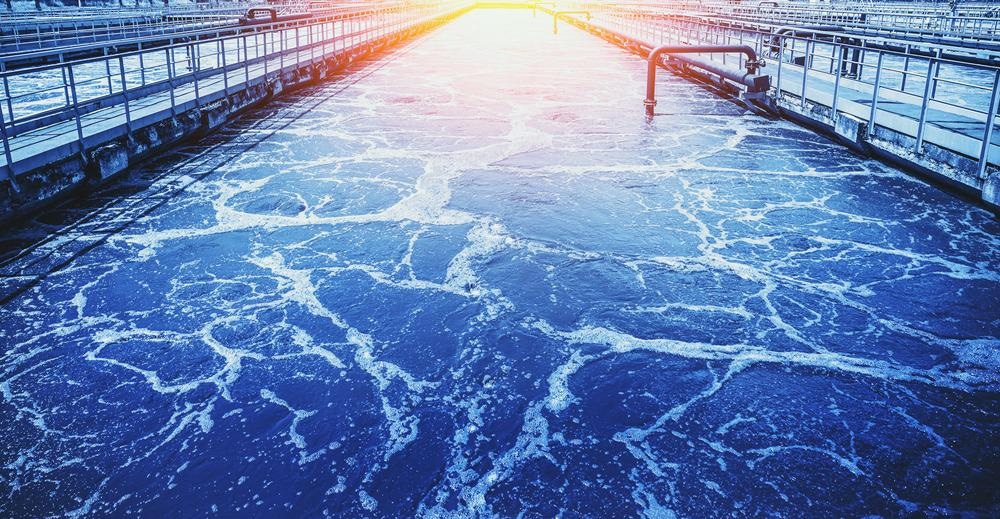According to a study published in Applied Nano Materials, a group of researchers described an easy and practical way of introducing phytic acid (PhA) molecules into GO lamellar to produce high-performance GO-based membranes for water filtration.

Study: Graphene Oxide Composite Membranes for Water Purification. Image Credit: DedMityay/Shutterstock.com
Graphene oxide (GO) has received a lot of attention as a potential material for next-generation membranes because of its higher moisture transparency and effectiveness.
PhA improved the hydrophilic nature and inter-layer spacing of the GO membrane. The optimum GP-10 nano-composite had a pristine water permeability of 6.32 L m-2 h-1 bar-1 at extreme low-pressure membrane filtration, which was around 18 % higher than that of the pure GO membrane's 0.32 L m-2 h-1 bar-1.
It also discarded loaded dye molecules with a response rate of 99.9 percent. Furthermore, the composite membrane remained structurally robust throughout a wide pH range.
This research not only demonstrates how to make GO-based membranes using multipurpose small molecules, as well as how to apply them to real-world water distillation problems.
Advantages of Membrane Filtration
In our modern civilization, elevated filtration techniques are crucial for solving water shortages and contamination. Membrane filtration has been extensively utilized in the purification of wastewater and seawater distillation as a cost-effective water treatment method because of its higher removal efficacy, high energy efficiency, easy implementation, and nontoxicity.
Nano-filtration (NF) is a filtration technology that operates at reduced pressure and has a higher absorption flux and rejection rate.
Limitations of Nano-Filtration Membrane
Conventional polymer-based nano-filtration membranes are vulnerable to frequent aging, cold temperatures and chemical inertness, and bio-fouling, which all restrict their usage in a wide range of applications and long-term functioning. Furthermore, removing the frequent transfer effect between permeability and selectivity in membrane processes connected to water purification remains a significant challenge.
As a result, the intelligent design of improved NF membranes has sparked a huge interest in the fields of water filtration and molecule separation.
Utilization of Graphene Oxide for Producing Effective NF Membranes
Researchers have recently focused their efforts on building high-performance NF membranes that optimize rejection rates with permeability.
Two-dimensional materials such as graphene and graphene oxide have been regarded as one of the most promising materials for developing next-generation enhanced NF membranes due to their high thermodynamic, physical, and structural durability, atomic density, and quick water distribution routes.
The concentration of oxygen-containing organic compounds on the boundaries and interface of the atomic-thick GO membranes offer potential water distribution characteristics.
Strategies to Enhance the Water Flux of GO-Based Membranes
Water flux is low in GO membranes, and increasing water flux across GO-based membranes without lowering the rejection rate is difficult.
Intercalating interlayer materials such as quantum dots, carbon nanotubes, and MoS2 into interfacial routes can enhance inter-lamellar distances. However, the large size and poor connections with the GO lamellar enhance the rise of interlayer distances, reducing membrane integrity and selectivity.
High insert levels promote unwanted swelling, resulting in the dissolution of interfacial van der Waals forces and a reduction in efficiency and selectivity.
Modification of Filtration Membrane by Hydrophilic Materials
The membrane's high rejection rate and water permeability can be further increased when utilized in conjunction with an inserter and a surface modification.
Synergistic membrane devices, on the other hand, are difficult and costly to produce. A simple technique is required to accurately manage membrane structure and maximize membrane function.
Phytic acid is a hydrophilic water-soluble naturally occurring molecule that is abundant in wheat and bean products.
PhA's phosphate groups possess several hydrogen bonds, allowing it to operate as an intercalator to change the distance between GO nanocomposite layers carrying oxygen-containing functional groups.
PhA is hydrophilic due to its hydrophilic groups. As a result, PhA can be utilized on GO-based membranes as both an inserter and a surface modification.
Research Findings and Conclusion
The researchers created high-performance lamellar GP hybrid membranes using vacuum filtration, with PhA acting as both an inserter and a surface enhancer to change GO nanostructures.
The GP composite membrane's higher penetration and strong rejection for charged dyes were due to better hydrophilicity and wider nano-channels. For dye solution, the improved membrane GP had a rejection rate of over 99.9 percent and water flux of 6.32 L m-2 h-1 bar-1.
Importantly, according to researchers the GP membrane was pH-tolerant and possesses good dye rejection durability. This research may help fabricate hybrid NF membranes by incorporating multifunctional small molecules.
Reference
Zhu, L., Guo, X., Chen, Y., Chen, Z., Lan, Y., Hong, Y. and Lan, W., 2022. Graphene Oxide Composite Membranes for Water Purification. ACS Applied Nano Materials. https://pubs.acs.org/doi/10.1021/acsanm.1c04322
Disclaimer: The views expressed here are those of the author expressed in their private capacity and do not necessarily represent the views of AZoM.com Limited T/A AZoNetwork the owner and operator of this website. This disclaimer forms part of the Terms and conditions of use of this website.